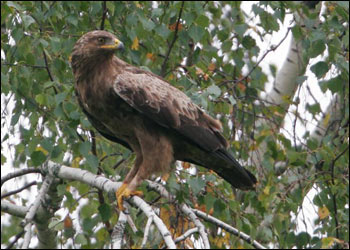Pratique | Débuter
Comment voient les oiseaux et comment limiter les collisions ?

L’acuité des oiseaux est globalement élevée, mais elle n’est pas exceptionnellement supérieure à celle des hommes, y compris chez les rapaces.Photographie : Urmas Sellis
Introduction
La vue est certainement le sens le plus important des oiseaux, qu’ils soient diurnes ou nocturnes. Leur vision est d’ailleurs l’une des meilleures du règne animal. Et pourtant des millions d’entre eux heurtent chaque année des immeubles, des lignes électriques ou des éoliennes, qui sont pourtant pour nous des obstacles a priori très visibles. La mortalité par collision constitue d’ailleurs la principale cause de décès non intentionnels causés par l’Homme et elle menace gravement certaines espèces (grands rapaces notamment).
Après une présentation de l’anatomie de l’œil aviaire, nous décrirons quelles sont les principales différences entre la vision des humains et celle des oiseaux, et nous verrons comment en déduire des pistes pour limiter les risques de collisions.
Abstract
Vision is the most important sense for birds, since good eyesight is essential for safe flight, and this group has a number of adaptations which give visual acuity superior to that of other vertebrate groups.
But many species are prone to colliding with large human-made objects, from office block windows to power lines and wind turbines, many of which appear difficult not to notice to human eyes.
How to explain this paradox ? It is indeed odd that birds so often collide with large objects as if they don’t see them.
After a presentation of the anatomy of the bird eyes, we will explain how birds see the world and what are the main differences with our vision, and then we will present the results of a new study recently published in IBIS outlines that propose new solutions to the problem of collisions based on the birds viewpoint.
Poursuivez la lecture de cet article, en vous abonnant dès maintenant !
Découvrez les Archives d’Ornithomedia.com
Pour seulement 10,00 €TTC/an (ou 6,00 € les 6 mois)
Profitez de plusieurs centaines d’articles en accès illimité et sans aucun engagement.
Compléments
À lire aussi sur Ornithomedia.com
Ouvrages recommandés
- Anatomie Des Oiseaux Frederic P. Miller, Agnes F. Vandome et John McBrewster
- Bird Anatomy II: The Surface Anatomy of Birds Noble S. Proctor et Patrick Lynch
- The Inner Bird: Anatomy and Evolution Gary W. Kaiser
- Le comportement animal : Psychobiologie, éthologie et évolution David McFarland, René Zayan et Jacqueline d’Huart
Sources
- Robert Bleiweiss (2004). Ultraviolet plumage reflectance distinguishes sibling bird species. PNAS. http://www.pnas.org/content/101/47/16561.full
- David McFarland (2009). Le comportement animal: psychobiologie, éthologie et évolution. De Boeck
- J. Rajchard (2009). Ultraviolet (UV) light perception by birds : a review. Veterinarni Medicina; 54. http://www.vri.cz/docs/vetmed/54-8-351.pdf
- GRAHAM R. MARTIN (2011). Understanding bird collisions with man-made objects: a sensory ecology approach. Ibis. British Ornithologists’ Union, 153, 239–254. http://dx.doi.org/10.1111/j.1474-919X.2011.01117.x
- Sciencedaily (2011). Not So Eagle Eyed: New Study Reveals Why Birds Collide With Human-Made Objects. Date de mise en ligne : 17/03. http://www.sciencedaily.com/releases/2011/03/110316222022.htm
- Wikipedia (2011). Birds vision.
- Peter Mullen (2006). Spectrophotometric Studies of Avian Plumage Coloration with Special Emphasis on the Ultraviolet Range. Angefertigt mit Genehmigung der Mathematisch-Naturwissenschaftlichen Fakultät der Rheinischen Friedrich-Wilhelms-Universität Bonn. http://deposit.ddb.de
- Jean-François Savard, Jason Keagy, Gerald Borgia (2011). Blue, not UV, plumage color is important in satin bowerbird Ptilonorhynchus violaceus display. Journal of Avian Biology. Volume 42, Issue 1, pages 80–84. http://onlinelibrary.wiley.com




Aucun commentaire sur ce sujet
Participer à la discussion !